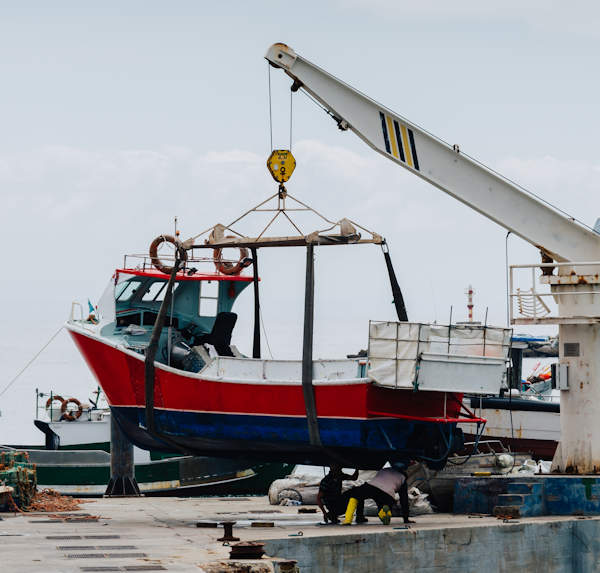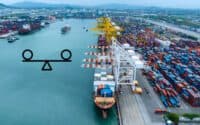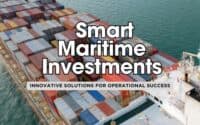A Definitive Introduction to the Breakbulk Industry

The Breakbulk Industry at a Glance Breakbulk might not be a household term for everyone, but it plays a pivotal role in the global trade ecosystem. At its core, the breakbulk industry concerns the transportation of goods that don’t fit into the standard container mold. Rather than using the regular container shipping methods we might be more familiar with, breakbulk tackles larger, heavier items, ensuring they reach their destinations safely.
* Please send feedback/suggestions to editor @ shipuniverse.com
Why Breakbulk Matters in Global Trade Imagine trying to ship a massive piece of machinery or an oversized wind turbine blade in a standard shipping container. It wouldn’t be feasible. That’s where breakbulk steps in. This industry ensures that large, heavy, or oddly shaped goods can be transported across continents and oceans. In essence, it’s a linchpin for sectors that require the movement of large-scale goods, fueling industries from energy to infrastructure.
What is Breakbulk?
Understanding Breakbulk Breakbulk, in its simplest form, refers to cargo that is too big, heavy, or uniquely shaped to fit into standard shipping containers. Instead of being loaded into these containers, breakbulk cargo is individually loaded onto ships, often on pallets, in crates, or even on skids.
Differentiating Breakbulk from Other Cargo Types At a port, you’ll likely see large containers stacked upon one another, waiting for transport. These are not breakbulk. They’re part of the container shipping industry. The primary difference between containerized and breakbulk cargo is the packaging and handling. While containerized goods are standardized for easy stacking and movement, breakbulk requires more specialized handling due to its non-standard sizes and weights.
Examples of Breakbulk Cargo To envision breakbulk, think of large construction equipment, turbines, factory parts, yachts, or even massive timber logs. These items can’t be squeezed into standard containers and need special attention and equipment for loading, stowing, and unloading.
History of the Breakbulk Industry
From Traditional to Modern Cargo Handling Before the invention and widespread adoption of standardized containers in the mid-20th century, most goods were shipped as breakbulk. Individual items, whether they were crates of tea, barrels of wine, or large machinery, were loaded piece by piece onto ships. This process was labor-intensive, time-consuming, and often less secure. However, with the rise of container shipping, many cargoes shifted to this new, more efficient method. But not all. Those items that couldn’t fit into containers remained as breakbulk, and as global industries grew and evolved, so did the importance and scale of the breakbulk industry.
Milestones in the Breakbulk Realm While it’s difficult to pinpoint every significant event in the history of breakbulk, some key moments stand out:
- Early Maritime Trade: Before modern shipping methods, all cargo was essentially breakbulk. From the ancient Phoenician trade routes to the European exploration era, goods were loaded individually onto ships.
- Industrial Revolution: The 18th and 19th centuries saw an uptick in the size and weight of machinery, leading to larger and more complex breakbulk shipments.
- Advent of Containerization: In the 1950s and 1960s, the introduction of standardized containers transformed global trade. While many goods moved to this new method, breakbulk remained crucial for out-of-gauge items.
- Modern Technological Advancements: With advancements in cranes, ships, and tracking technology, today’s breakbulk industry can handle larger cargoes more efficiently and safely than ever before.
Key Players in the Breakbulk Industry
Cargo Owners and Manufacturers Overview: These are the businesses or individuals that produce or own the cargo being shipped. They could be large-scale industrial manufacturers producing heavy machinery or smaller entities like farming cooperatives exporting large equipment. Role: Their primary role is to ensure their cargo is ready for shipment, adhering to international standards, and coordinating with other stakeholders for smooth transportation.
Freight Forwarders and Logistics Providers Overview: Freight forwarders act as intermediaries between cargo owners and transportation services, ensuring a seamless transition of goods from one point to another. Role: They handle booking cargo space, negotiating transport rates, and ensuring the right mode of transport is chosen based on cargo type. Additionally, they might assist with customs paperwork and other documentation necessary for international shipping.
Carriers: Types and Roles Overview: Carriers are responsible for physically transporting the breakbulk cargo from its origin to its destination. Types: There are several types of carriers, including:
- Shipping Lines: Specializing in sea freight, they operate cargo ships.
- Trucking Companies: Handling road transport, especially for shorter distances or last-mile delivery.
- Rail Operators: Taking care of rail transportation, which might be ideal for large cargoes traveling overland for extended distances. Role: Carriers ensure the safe and timely transportation of cargo, adhering to all safety and regulatory standards.
Port Terminals and Their Significance Overview: Ports act as gateways for international trade. Within ports, specific terminals are often designated for handling breakbulk cargo. Significance: Given the unique nature of breakbulk items, these terminals are equipped with specialized equipment and facilities to handle non-containerized goods. They are essential for the loading and unloading of breakbulk from ships, and their efficiency can heavily influence shipping timelines and costs.
The Breakbulk Process
Pre-Shipment Planning Overview: Before any cargo is moved, meticulous planning is necessary to ensure a smooth shipping process. Steps: This phase involves understanding the nature of the cargo (size, weight, fragility), selecting the right mode of transport, and estimating costs and timelines.
Packing and Stowage Overview: Preparing breakbulk for shipment is a delicate process due to its non-standard dimensions and often high value. Steps: Items must be adequately packed to prevent damage. This might involve crating, securing on pallets, or wrapping. Stowage refers to how these items are stored in a ship, ensuring stability during transport.
Transportation: Road, Rail, and Sea Overview: Depending on the journey, breakbulk might travel by a combination of road, rail, or sea. Steps: Each mode of transport requires different handling. For instance, transporting by sea might involve securing cargo on a ship’s deck, while rail might require specialized flatbed cars.
Documentation and Customs Overview: International shipping involves a lot of paperwork, especially for unique items typical of breakbulk. Steps: Accurate documentation ensures cargo passes through customs without delays. This might include bills of lading, certificates of origin, and customs declaration forms.
Delivery and Post-Shipment Activities Overview: Once the cargo reaches its destination, the process isn’t necessarily over. Steps: Cargo must be unloaded, inspected for damage, and then possibly transported further to its final destination. Post-shipment can also involve customer feedback, payment settlements, and planning for any return shipments.
Challenges in the Breakbulk Industry
Physical Challenges: Handling, Stowage, and Transport Overview: Due to the unique sizes, weights, and shapes of breakbulk cargo, handling such cargo often presents challenges not encountered with standardized shipping containers. Handling: Specialized equipment, like heavy-lift cranes, is often required to move and load breakbulk cargo. Incorrect handling can lead to damaged goods or injuries. Stowage: Ensuring stability during transport is vital. Improper stowage can cause cargo to shift during transit, leading to damages or even compromising the safety of the vessel. Transport: Choosing the right mode of transport (road, rail, sea) based on the cargo’s dimensions and destination can be complex.
Regulatory and Documentation Challenges Overview: International shipping is governed by a plethora of regulations which can vary from one country to another. Regulations: Different countries might have varying safety and inspection standards. Navigating these regulations without causing delays requires expertise. Documentation: Maintaining accurate, detailed records is crucial for customs clearance. Errors or omissions can lead to significant delays and potential financial penalties.
Economic Factors Affecting the Industry Overview: Like all industries, breakbulk shipping is subject to the ebbs and flows of the global economy. Factors: Economic downturns can lead to decreased demand for heavy machinery or infrastructure components, directly impacting the breakbulk industry. Conversely, economic booms can strain capacity, leading to increased costs.
Environmental Concerns Overview: Environmental awareness is increasing globally, and the shipping industry is no exception. Challenges: Breakbulk shipping can have environmental impacts, from emissions of large vessels to the potential ecological effects of infrastructure projects the shipped items are used for.
Technologies Transforming Breakbulk
Digitalization and its Impact Overview: The digital transformation is reshaping many industries, including breakbulk shipping. Effects: Digital platforms now allow for more efficient booking, tracking, and management of shipments. Electronic documentation can streamline customs clearance, and predictive analytics can optimize routes and reduce costs.
Automation in Ports and Terminals Overview: Ports and terminals are integrating advanced technologies to boost efficiency. Benefits: Automated cranes and transport vehicles can reduce loading and unloading times. Computer systems can optimize stowage plans to ensure stability and efficient use of space.
Innovations in Shipping: Vessels, Equipment, and Tracking Overview: Technological advancements are continually refining the tools of the trade in breakbulk shipping. Vessels: Newer ships are designed for energy efficiency, reduced emissions, and increased capacity. Some are even equipped with advanced stabilization systems to better handle sensitive cargo. Equipment: From stronger, more adaptable cranes to specialized stowage solutions, equipment innovations continue to make breakbulk shipping safer and more efficient. Tracking: Real-time tracking systems using GPS and other technologies allow cargo owners to monitor their shipments’ progress and condition (like temperature or humidity) continuously.
The Role of Breakbulk Events and Conferences
Networking Opportunities Overview: One of the primary attractions of attending events and conferences is the chance to network. Benefits: Professionals can forge new business relationships, seek out potential partnerships, and reinforce existing connections in a face-to-face environment.
Knowledge Sharing and Industry Updates Overview: Conferences serve as a platform for sharing the latest research, technological advancements, and industry best practices. Impact: Attendees can gain a competitive edge by staying updated on the latest techniques, technologies, and market trends. Such gatherings also foster a culture of continuous learning within the industry.
Importance of Events like Breakbulk Americas Overview: Breakbulk Americas is one of the premier events for the breakbulk industry. Significance: It showcases the latest innovations, gathers experts from across the globe, and offers unique insights into the future of the industry. For many professionals, attending such an event is essential to maintain a pulse on the industry’s heartbeat.
Future Trends in the Breakbulk Industry
The Rise of Mega Projects and its Impact Overview: As global infrastructure needs grow, so does the demand for large-scale projects. Impact: These mega-projects, from bridges to power plants, require massive, non-standardized equipment and parts. The breakbulk industry is pivotal in ensuring these components reach their destinations.
Sustainability and Green Shipping Overview: Environmental concerns are pushing industries towards greener practices. In Breakbulk: The industry is exploring more energy-efficient ships, cleaner fuels, and carbon offset programs. The focus is not just on reducing the carbon footprint but also on overall sustainability, from materials used to waste produced.
The Interplay of Containerization and Breakbulk Overview: While containerization revolutionized cargo transport, not all goods fit neatly into standard containers. Interplay: The two forms of transport will continue to coexist. Still, the breakbulk industry will need to find its niche, focusing on specialized cargos while also exploring hybrid solutions that combine the best of both worlds.
Recap of the Significance of the Breakbulk Industry The breakbulk industry has long played an essential role in global trade, ensuring that oversized, unique, and essential cargos reach their destinations. As global needs evolve, so too will the industry, adapting to new challenges and leveraging technological advancements.
Encouragement to Stay Updated and Engaged The world of breakbulk is dynamic. For professionals and stakeholders, staying engaged with industry updates, attending events, and continuously learning will be crucial for success in the coming years.
Additional Resources
Organizations:
- Breakbulk Events & Media
- Overview: Organizes some of the biggest events in the breakbulk industry and offers a platform for news, insights, and community building.
- Link to the website
- The Heavy Lift & Project Forwarding International (HLPFI)
- Overview: A leading media outlet that covers heavy lift, project logistics, and breakbulk news.
- Link to the website
- Project Cargo Network (PCN)
- Overview: An organization that brings together the world’s top project cargo and heavy lift specialists.
- Link to the website
Events:
- Breakbulk Americas
- Overview: As one of the largest events for the breakbulk industry in the Americas, it gathers professionals from around the globe.
- Link to the event page
- Breakbulk Europe
- Overview: Europe’s largest event for the breakbulk community, providing networking opportunities and insights into the European market.
- Link to the event page
- Breakbulk Middle East
- Overview: An event that addresses the opportunities and challenges in the Middle Eastern breakbulk sector.
- Link to the event page
- Antwerp XL
- Overview: Based in one of Europe’s largest ports, this event focuses on breakbulk, heavy lift, and project cargo sectors.
- Link to the event page

Do you have a Maritime Product or Service that may be of interest to Shipowners? Tell us about it here!
Do you have feedback or insights? Please reach out to editor @ shipuniverse.com



